Imagine discovering a forgotten treasure tucked away in your attic or garage, only to find out it’s an antique sled. Intrigued by its uniqueness, you might wonder about its history, value, and how to properly identify it. In this guide, we’ll delve into the fascinating world of antique sleds, offering tips for identification and discussing factors that determine their value.
As you embark on this journey, it’s essential to pay attention to certain distinguishing features of antique sleds. Look for a solid wood body, blunt ice-blades, and designer runners. Uneven edges, faded finishes on the seats, and brush bows also hint at the sled’s antiquity. For those in search of limited-edition models, you should keep an eye out for shapes like swan, birds, or horses. Some antique sleds may come without brand names, making it all the more essential to be familiar with the telltale signs of vintage craftsmanship.
While identifying antique sleds is fundamental, understanding their worth adds depth to your newfound knowledge. Factors such as condition, rarity, design, decoration, brand, and age all contribute to a sled’s value. With this guide at your disposal, you’re well-equipped to venture into the world of antique sleds, appreciating the history and artistry that make these pieces so captivating.
Table of Contents
Historical Background
Late 19th Century
In the late 19th century, sleds underwent significant improvements in design and construction. Makers started producing sturdier and fancier sleds, and sledding evolved into an everyday sport. Some noteworthy developments from this era include:
- Steel-hinged sleds of the 1850s: these sleds offered greater durability and flexibility than their wooden predecessors.
- The introduction of the Flexible Flyer in 1889: this sled became iconic for its innovative steering mechanism and sleek design. Tens of thousands of these sleds were produced, and they are still being manufactured today.
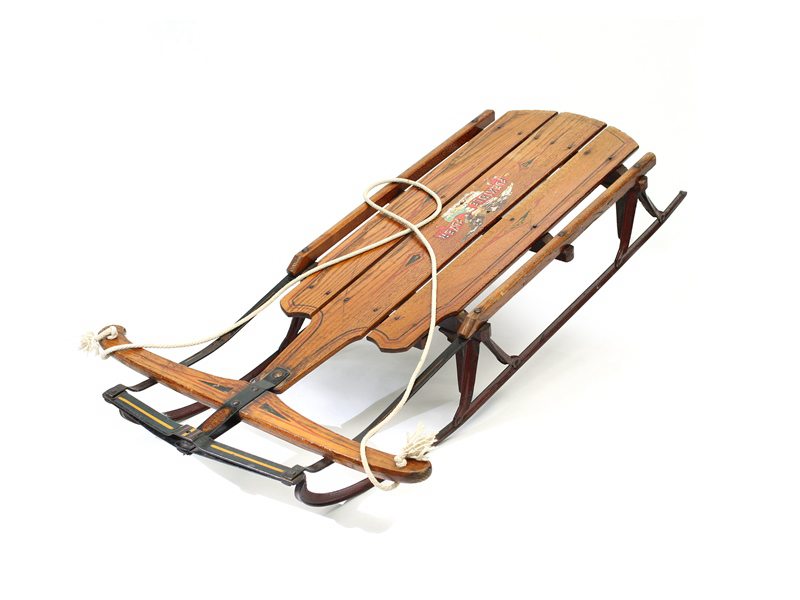
Early 20th Century
The early 20th century saw further advancements in sled technology and design. Some key milestones of this period include:
- Expansion of brands: Many companies entered the market, producing various types and styles of sleds. Major brands of the era included Paris Manufacturing Company, Garton Toy Company, and S.L. Allen & Company (Flexible Flyer brand).
- Artisan sleds: Custom-made sleds often featured intricate carvings, detailed paintwork, and high-quality materials. These sleds were considered luxury items and are highly sought after by collectors today.
- Push sleds and toboggans: With the emergence of ski resorts and winter recreation areas, push sleds and toboggans gained popularity for leisurely downhill activities. These sleds typically had a simple design and lacked the complex steering mechanisms found on Flexible Flyers.
While researching antique sleds, remember to consider factors such as materials, construction, brand, design, and age when determining their value. In general, sleds in good condition and of rare or intricate design will command higher prices.
Types of Antique Sled and Their Valuation
In this section, we will discuss various types of antique sleds and their respective valuations. It’s crucial to understand the different categories as they can significantly impact the sled’s value.
Ski Sled
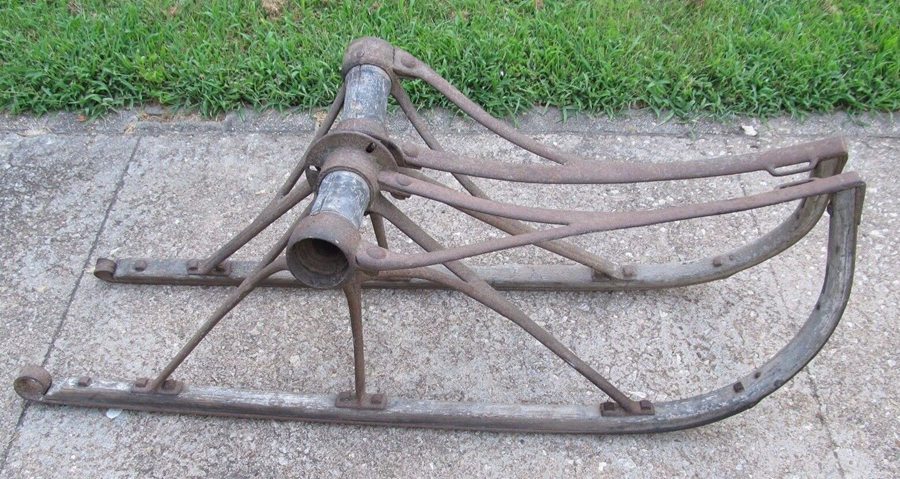
Ski sleds are a popular type of antique sled, typically made from solid wood with metal or wooden runners. These sleds were used for transporting goods and people over snow:
- Price Range: Ski sleds can be valued between $100 to $500, depending on their condition, rarity, and age.
Dog Sled
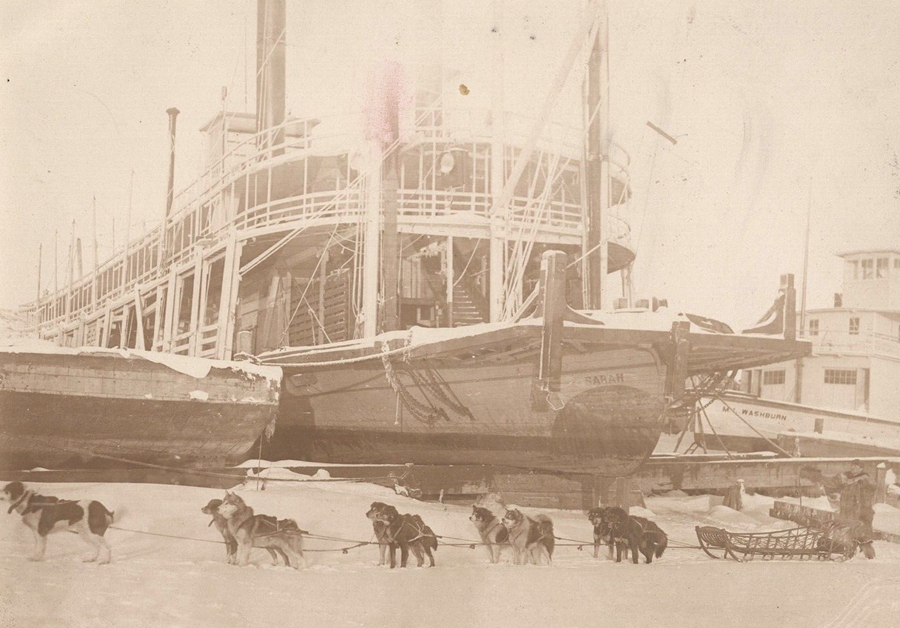
Dog sleds were primarily used for transportation and work, often for pulling heavy loads or for long-distance travel in snowy conditions:
- Price Range: Antique dog sleds usually have a price range of $200 to $800, with rarer and well-preserved examples fetching higher values.
Horse Sled
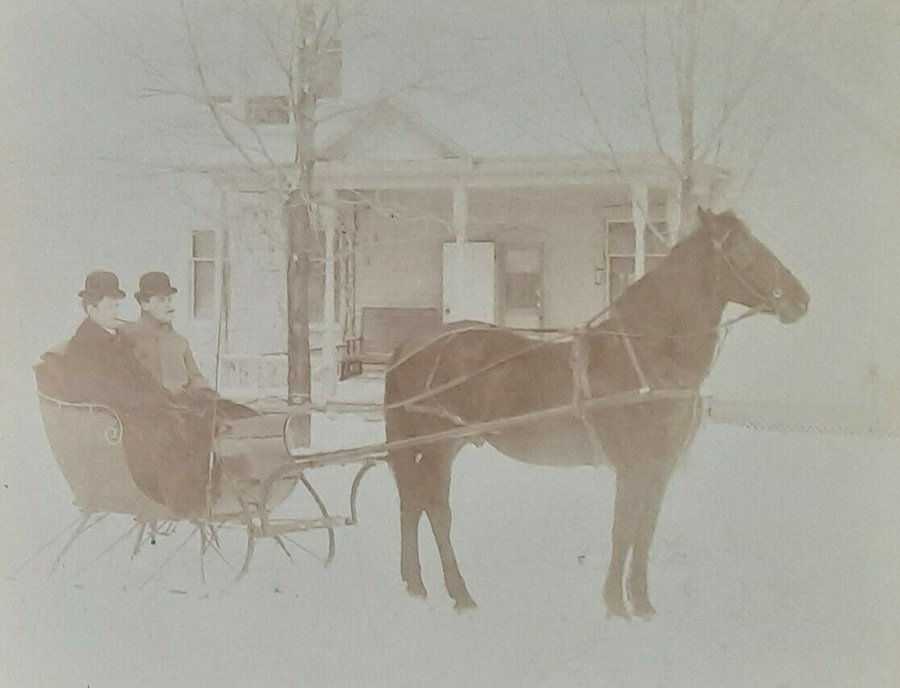
Horse sleds, as the name implies, were designed to be pulled by horses. These sleds were often larger and more ornate than other types of sleds, and they can be highly sought after by collectors:
- Price Range: The value of a horse sled varies widely but can typically range from $300 to $1500, depending on factors like condition, rarity, and design.
Wooden Sled
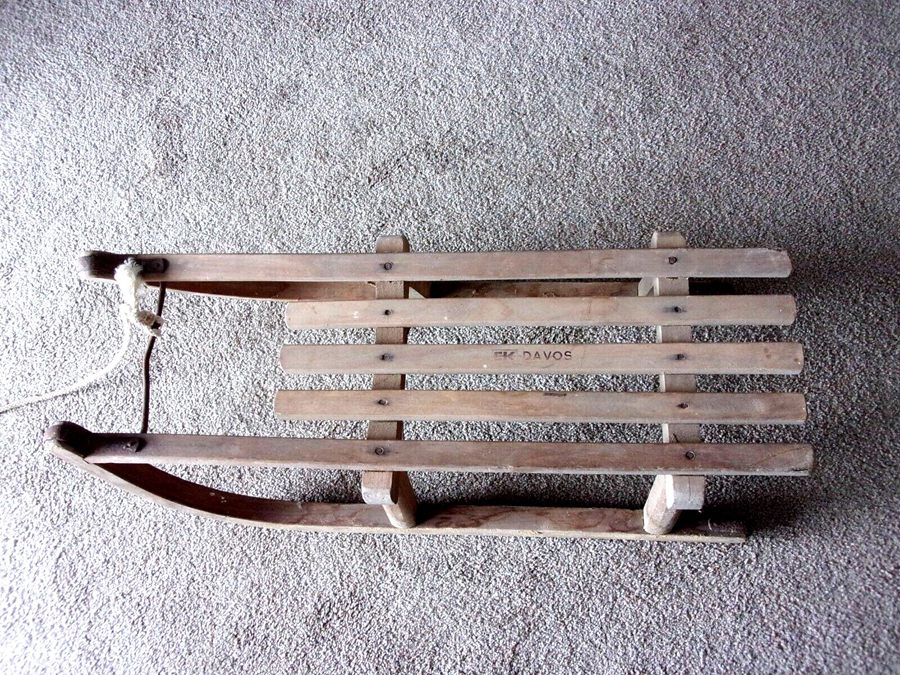
All-wooden sleds are the most traditional form of antique sled, with beautiful craftsmanship and designs that have stood the test of time:
- Price Range: A wooden sled’s value starts at around $40, but well-preserved, unique, and antique examples can reach up to $125 or more.
Ice and Grass Sled
Ice and grass sleds were versatile and could be used on both ice and grassy surfaces. These sleds often had metal runners and may feature intricate designs:
- Price Range: The value of an ice and grass sled can range from $100 to $600, with rarer and better-maintained sleds commanding higher values.
Skiing Handcart
Skiing handcarts were a unique type of sled with an elongated design that could be pushed or pulled by a person on skis. They were often used for transporting goods or people:
- Price Range: The valuation of skiing handcarts varies significantly, but they can typically be valued between $200 and $1000, with rarer or specialized examples going for higher prices.
8 Factors to Identify & Value an Antique Sled
1. Age and Historical Background of the Sled
Sledding has a long and rich history, dating back to ancient times. The oldest evidence of sledding was found between 110 and 101 B.C., during the Cimbric War, when Celtic and Germanic tribes used sleds to travel down the Alps and gain an advantage over the Romans. Sledding as a recreational activity emerged in Russia during the 17th century.
In the 1800s, sled makers began manufacturing more robust and visually appealing sleds, leading to an increase in popularity as an everyday sport. By the 1850s, steel-hinged sleds were introduced, which significantly improved their durability.
Antique sleds can be identified and valued based on factors such as age, patent number, type, and average estimated value. Here’s a table with some examples to help you better understand antique sled valuation:
| Age | Patent Number | Type | Average Estimated Value |
|---|---|---|---|
| Late 19th century | Various | Flexible Flyer | $200 – $300 |
| Early 20th century | Various | Paris Manufacturing Sled | $150 – $250 |
| 1920s | Various | Artisan Sled | $300 – $450 |
| 1930s | Various | Push Sled | $250 – $350 |
When identifying an antique sled, pay attention to the brand, as some of the old ones, like Flexible Flyer and the Paris Manufacturing Company, have been producing sleds since the late 19th century. Knowing the brand can help you determine when the sled was made and potentially increase its value.
2. Manufacturer and Brand
When identifying and valuing an antique sled, one of the first things to look for is the manufacturer and brand. Some of the most recognizable sled manufacturers in the 19th century were Flexible Flyer and Paris Manufacturing. Once you find the manufacturer and its stamp, you can effortlessly identify the period when they were made.
Beyond the manufacturer, it’s important to examine the sled’s design, shape, and construction. The shape can help determine if it’s a push sled or a pull sled. Most antique sleds are pull sleds, where a rope would be used to tow the sled back up the hill after sliding down.
Here is a table with some examples of manufacturers, antique sled models, and types, as well as their average estimated values:
| Manufacturer | Antique Sled Model | Type | Average Estimated Value |
|---|---|---|---|
| Flexible Flyer | Model 1 | Pull Sled | $150 – $300 |
| Paris Manufacturing | Wooden Master | Pull Sled | $200 – $400 |
| Unknown Artisan | Hand-Painted Sled | Push Sled | $100 – $200 |
Keep in mind that these values may vary depending on the sled’s condition, rarity, and design features. Factors such as age can also play a role in determining the value of an antique sled. For example, older sleds from the 1700s may have larger seats, measuring around 23-25 inches, reflecting the period in which they were made.
For a more accurate identification and evaluation of your antique sled, consult reputable resources, and speak with experts who specialize in this unique collectible area. By doing so, you will gain a deeper understanding of your sled’s history and value, ensuring you appreciate its place in the world of antiques.
3. Materials and Manufacturing Methods
When identifying and valuing antique sleds, understanding the materials and manufacturing methods used in their production is essential. Over the years, various materials have been utilized, helping to determine the era and quality of a given sled.
Wood and Metal Materials
In the early days, most antique sleds were made from wood, with some metal components such as runners and fittings. The type of wood used can provide valuable information:
- Ash: Common in sleds from the 19th century, ash is strong and flexible.
- Maple: A dense and durable wood that was also used in many antique sleds.
- Pine: A less expensive, lighter material which indicates a more basic sled design.
Metal components, including flat or round runner designs, also influence the value:
- Iron: Used in early sleds, adding weight and durability.
- Steel: Introduced later, steel provided sleeker designs and improved performance.
Manufacturing Methods
Different manufacturing techniques help identify specific brands or production eras:
- Handcrafted: Early sleds were entirely hand-made, with intricate carvings and finer craftsmanship.
- Mass production: The introduction of mass production saw a shift towards more streamlined, standardized designs.
| Era | Handcrafted | Mass-produced |
|---|---|---|
| 19th Century | X | |
| Early 20th Century | X |
By examining the materials and manufacturing methods of an antique sled, you can better determine its value. For example, a handcrafted sled from the 19th century with ash wood and iron components may receive a higher valuation than a mass-produced sled from the early 20th century. Keep these factors in mind as you explore the antique sled market.
4. Condition and Completeness
When identifying and assessing the value of an antique sled, consider the condition and completeness of the item. The overall state of the sled, including the structural integrity and originality, plays a significant role in determining its value.
Start by inspecting the sled for any major structural damages. Keep an eye out for cracks, missing or replaced parts, and signs of restoration. A well-preserved sled with all of its original components intact will command a higher price.
Next, check for signs of wear, such as paint loss and weathering. These factors can influence value as well, since signs of normal wear can actually add character and authenticity to the sled. However, excessive wear or signs of mistreatment could negatively impact its value.
Here are some key factors to consider when evaluating the condition and completeness of an antique sled:
- Structural integrity
- Original components and hardware
- Signs of wear and weathering
- Any repairs or restorations
Below is a table of average estimated values for antique sleds based on their condition:
| Condition | Average Estimated Value |
|---|---|
| Excellent | $350 – $500 |
| Good | $200 – $350 |
| Fair | $100 – $200 |
| Poor/Incomplete | $50 – $100 |
Keep in mind that these values are approximate and can vary depending on factors such as rarity, maker, and historical significance. It’s essential to research individual pieces more extensively to determine accurate values.
5. Shape of the Runners
When identifying antique sleds, pay close attention to the shape of the runners. These can provide valuable clues to the sled’s origin, age, and value.
Runners on antique sleds can vary in design. Some are simple and plain, while others may have intricate patterns or carvings. It’s essential to examine them closely when determining your sled’s value.
- For wooden sleds with metal runners, you might find unique shapes like animals or mythical creatures. These artistic designs increase the sled’s value and are less common to find intact.
- Antique sleds may have crude or hand-crafted appearances. If your sled doesn’t have a brand name and appears hand-constructed, it could indicate an antique handmade sled, which adds to its historical interest.
Price Range for Different Runner Shapes:
| Runner Shape | Average Estimated Value |
|---|---|
| Simple and plain | $30 – $50 USD |
| Animal shapes | $100 – $200 USD |
| Mythical creatures | $200 – $500 USD |
| Handmade | $100 – $300 USD |
Keep in mind that these are rough estimates and many factors will determine the actual value of your antique sled, such as its condition, rarity, brand, and age. Consult with an antiques expert for a more accurate appraisal.
6. Color of the Wheels
When identifying the value of an antique sled, one important aspect to consider is the color of the wheels. While some antique sleds have wooden runners, others feature metal wheels. The color and condition of these wheels can play a significant role in determining the sled’s overall value and may also help identify its origin or brand.
To evaluate your sled’s wheels, take note of the following:
- Material: Are the wheels made of wood or metal? Generally, wooden wheels indicate that the sled is an older model, while metal wheels suggest a more modern design.
- Color: Examine the color or paint on the wheels. Some antique sled brands, like Flexible Flyer, have characteristic wheel colors that can help identify the sled and give a better sense of its timeline. For instance, early 1890s Flexible Flyer FF No. 12 models originally had red wheels.
- Condition: Check for signs of wear and rust on the metal wheels. A sled with well-preserved wheels is likely to be more valuable than one with damaged or heavily rusted wheels.
- Design: Inspect any markings, logos, or graphics on the wheels as these may provide clues about the sled’s maker and further aid in the identification process.
As requested, here is a sample table displaying various wheel colors and their corresponding average estimated values:
| Wheel Color | Average Estimated Value |
|---|---|
| Red | $150 – $300 |
| Green | $100 – $250 |
| Blue | $75 – $200 |
| Black | $50 – $150 |
Please note that these values are just an example and should not be considered definitive. The actual value of an antique sled may vary depending on factors such as condition, age, and rarity. For a more accurate appraisal, it’s recommended to consult with an antiques expert or review dedicated antique sled price guides.
7. Seat Material
When identifying an antique sled, one of the key aspects to consider is the seat material. The seat material can offer valuable insight into the age, craftsmanship, and potentially the value of your antique sled. In this section, we will explore various seat materials commonly found on antique sleds.
Wooden seats are a hallmark of many antique sleds, particularly those that were handcrafted. Carefully inspect the wood for grain, texture, and the presence of any intricate carvings or decorations. These elements can provide additional information about the sled’s origin, age, and potential value.
Metal seats, on the other hand, are typical of more recent sleds or those that were commercially manufactured. Generally made from iron or steel, metal seats offer durability and resistance to wear. Some metal seats may even feature decorative elements or brand logos, which can further assist in determining the sled’s value.
Woven seats, crafted with materials such as rope or wicker, are another type of seat material you may encounter on your antique sled. These seats were often fashioned with a sense of practicality and comfort in mind, and may suggest that the sled was intended for leisurely use.
Here is a table with an average estimated value for each seat material:
| Seat Material | Average Estimated Value |
|---|---|
| Wood | $150 – $400 |
| Metal | $75 – $250 |
| Woven | $100 – $300 |
Again, remember that the values provided in this table are only estimates and may vary significantly depending on other factors, such as the sled’s condition, age, and rarity. When identifying and valuing your antique sled, it is crucial to consider multiple aspects and consult reputable resources to gain a comprehensive understanding of its worth.
8. Rarity and Uniqueness
When identifying the value of antique sleds, rarity and uniqueness play a significant role. The more rare a sled is, the more valuable it tends to be.
Some sleds are considered rare because they were produced in limited quantities or were custom made. These sleds were often handmade and, as a result, can be quite valuable to collectors. In addition, the materials and craftsmanship used in the manufacturing of these sleds make them unique and desirable.
An important factor in assessing the rarity and uniqueness of an antique sled is its condition. An antique sled in excellent condition and with original parts is typically more valuable than those with missing or damaged components.
To give you an idea of sled values based on their rarity and uniqueness, here is a table of average estimated values:
| Sled Model | Condition | Average Estimated Value |
|---|---|---|
| Rare Four-Seat Flexible Flyer | Excellent | $1,000 |
| Yankee Clipper | Very Good | $100 |
| Common Flexible Flyer (42″ Model) | Good | $50 |
Keep in mind that these values are just estimates, and actual values could be higher or lower, depending on the specific sled and the current market. It is always a good idea to consult with an appraisal expert for a more accurate evaluation.
You can also check online marketplaces, such as eBay and 1st Dibs, to have an idea of the current market prices for different sled models. This will help you determine how rare and unique your sled is and give you a better understanding of its value. Remember, rarity and uniqueness are important factors in determining the value of antique sleds, and identifying these features will ultimately help you assess the worth of your sled.
Popular Antique Sled Brands
When you’re exploring the world of antique sleds, some brands tend to stand out more than others. In this section, we will be discussing a few popular antique sled brands that you might come across in your search.
One of the most iconic antique sled brands is Flexible Flyer. This American sled brand has a long history that dates back to 1889. The sled’s unique design, featuring a patented steering system, made it a popular choice for children and adults alike. Flexible Flyers are highly sought after by collectors due to their innovative design and nostalgic appeal. Keep an eye out for these sleds as they can be valuable, especially if they are in good condition with the original paint and decals.
Another well-known antique sled brand is the Paris Manufacturing Company. Established in 1861, this Maine-based company quickly gained a reputation for crafting high-quality sleds using a combination of steam-powered machinery and skilled handiwork. Some Paris sleds feature beautiful hand-painted designs, making them an attractive find for collectors. Look for their trademark logo, which often includes the name “Paris” or the abbreviation “P.M. Co.” to identify their sleds.
As you continue your search for antique sleds, be sure to also explore other brands and their unique sled designs, such as:
- Snoracer: Known for their distinctive racing-inspired sleds with steering wheels.
- Sherwood: A Canadian brand producing sleds with sleek designs and sturdy construction.
Be mindful of the condition, rarity, and age of the sleds you come across, as these factors contribute to their value. Additionally, don’t be afraid to delve into lesser-known brands, as you may uncover hidden gems that have their own unique stories and charm.
Remember, when assessing the value of an antique sled, your knowledge about the various brands, their histories, and distinguishing features will be of immense aid. By keeping this information in mind, you’ll be better equipped to uncover treasures and build a collection that truly showcases the rich history of these timeless toys.
Value of Antique Sleds
Factors Affecting Value
When assessing the value of antique sleds, consider the following factors:
- Age: Generally, older sleds are more valuable. For example, sleds from the 1700s typically measure around 23-25 inches and are considered more precious.
- Brand and color: The demand for antique sleds can vary depending on the brand and color.
- Condition: A sled with all preserved parts and intact original paint will be worth the most.
- Rarity: Unique and rare sled designs, like 4-seat Flexible Flyers or push sleds made for children, may fetch higher prices.
Keep in mind that the average price for an antique sled is around $200-$400, with rarer pieces going for more. Values can range from as low as $30 to over $500.
Suggestions for Appraisal
To get an accurate value for your antique sled, consider the following suggestions:
- Examine the sled: Carefully look at the condition and any distinguishing features to help determine its value.
- Consult online resources: Use antique sled identification and price guides to get an idea of similar sleds’ worth.
- Get a professional appraisal: If you have a potentially valuable sled, consider getting an antique toy appraisal.
When trying to locate valuable antique sleds, it could be helpful to:
- Take pictures: Documenting the sled in photographs will help in the appraisal process, as well as for potential buyers or online sales.
- Research the history: Learning about the sled’s story and background can add value to the piece.
- Preserve the sled: Ensure your antique sled is kept in the best condition possible, as this will maintain or increase its value.
Use this guide to help you better understand the value of your antique sled and to evaluate your piece. Remember, each sled is unique and may have different values based on the factors discussed above.
Places to Buy Antique Sleds
eBay
eBay is a popular marketplace for finding a wide variety of antique sleds. With prices ranging from $50 to $1,200, you can discover anything from tobogganers to high-end metal runner sleds that have a charming, rustic appearance.
To ensure you are purchasing an authentic antique sled, pay attention to the seller’s reputation and feedback. Ask for additional pictures, if necessary, to confirm the sled’s condition and origin. When bidding or buying, consider your budget, and don’t forget to factor in shipping costs, as sleds can be bulky and heavy items. Be prepared to invest time in your search, as finding the perfect antique sled for you might take some patience.
Antique Stores
Visiting local antique stores can be a rewarding experience when searching for antique sleds. These stores often carry a range of antiques, which may include sleds of various styles, brands, and ages. When shopping in-person, you have the advantage of inspecting the sled’s construction, materials, and artistry up close before making a purchase.
When browsing antique stores, keep an eye out for well-known brands like Flexible Flyer and Paris Manufacturing Company sleds. Additionally, don’t hesitate to ask the store employees for assistance when it comes to identifying the sled’s age, value, and history. Don’t be afraid to negotiate on the price, as many antique stores may be open to discussing discounts. To get the most out of your shopping experience, consider visiting multiple stores and get a feel for the antique sleds available in your area.
The Nostalgia of Antique Sleds
Imagine yourself as a child, bundled up in warm clothing, your breath fogging up the chilly air, and your excitement couldn’t be more palpable. You’re about to embark on a thrilling, snow-covered adventure with your trusty antique sled.
Antique sleds are not only beautiful, handcrafted expressions of a bygone era, but they also provide a delightful sense of nostalgia for the simple childhood joys of sledding. From their intricate designs, solid wood construction, and elegant curves of the metal runners, these sleds truly capture the essence of classic wintertime fun.
Joan Palicia, a notable collector and sled enthusiast, reminds us that antique sleds are not just mere relics of the past, but rather precious keepsakes that evoke cherished memories. As you look upon your antique sled, you might fondly recall the laughter, camaraderie, and exhilaration of racing down snow-covered hills with your siblings or friends.
Consider the craftsmanship that went into creating your sled. Many antique sleds were handmade, sometimes by a family member or a friend, making each one unique and special in its own way. The materials used in their construction, such as the type of wood and the steel for the runners, give each sled its distinctive character and charm.
When displaying your antique sled in your home, take time to appreciate its beauty and the history that it represents. You may even choose to share your love of sleds with others by connecting with fellow collectors, participating in antique sled events, or attending sledding meetups to exchange stories and celebrate the nostalgia of these winter treasures.
Cherish your antique sled, and let it serve as a gentle reminder of the simple joys of winter and the magic of childhood.
Caring for Antique Snow Sleds
Caring for antique snow sleds is essential to preserving their value and appearance. Follow these steps to ensure your sled remains in top condition.
- Cleaning the Sled: Begin by dusting off any accumulated dirt and debris on your sled. After, use a soft cloth lightly dampened with water and a gentle cleaning agent to clean the surface. Be cautious not to use harsh chemicals that can damage your sled’s finish.
- Maintain the Wood: Check for any cracks or splits in the wood, as these can affect the sled’s structural integrity and value. Treat the antique sled’s wooden parts with a wood conditioner or oil to prevent drying out. Avoid exposing the sled to extreme temperature or humidity changes, as this can lead to warping or damage.
- Inspect Metal Components: Examine any metal parts on your sled, such as runners, for signs of rust or corrosion. Remove any small patches of rust with a wire brush, then coat the metal with a rust inhibitor. Be sure to keep metal parts lubricated to prevent further rust buildup.
- Store Properly: When storing your antique sled, avoid placing it in direct sunlight or damp environments, as these can cause discoloration and damage. Ideally, store your sled in a climate-controlled location with a consistent temperature and humidity level.
- Display Considerations: If you are displaying your antique sled, choose an area with minimal foot traffic, as accidents can happen. Consider hanging it on a wall or placing it on a stand to reduce potential damage from bumps or falls.
Remember, regular maintenance and proper storage are vital to preserving the value and appearance of your antique snow sled. By taking these steps, you can enjoy your snow sled for years to come.
Final Thoughts
When identifying an antique sled, there are several factors to consider. Keep in mind that due to deterioration of materials, especially wood, it can be challenging to determine the age of a sled.
- Manufacturer’s Branding: If your sled lacks a manufacturer’s name or date, it might be handmade, which adds to its uniqueness.
- Sled Age & Size: A larger seat on a sled often means it’s older and more valuable. For example, sleds from the 1700s typically measure around 23-25 inches.
- Design & Personalization: Pay attention to unusual or unique features in design or construction, such as hand-painted details or customized shapes. These elements may affect the sled’s value.
Remember, you always want to avoid making false or exaggerated claims about your sled. If you’re unsure about any aspect of its identification or value, consider consulting with an expert who specializes in antique sleds. This can ensure you are accurately assessing your sled and providing potential buyers with the most reliable information. Happy sledding!
FAQ
Q: How can I identify an antique sled?
A: When trying to identify an antique sled, you can consider the following characteristics:
- Material & Construction: Antique sleds were typically made of wood and had hand-crafted features.
- Identifying Brands: Look for brand or manufacturer names on the sled, such as Flexible Flyer or Paris Manufacturing Company.
- Artisan Sleds: Some antique sleds were hand-made by local artisans. Look for indications that your sled was crafted by hand.
- Push Sleds and Toboggans: Different sled designs can help determine the era the sled was made in. For example, push sleds date back to a different time period than pull sleds.
Q: What factors determine an antique sled’s value?
A: Antique sled values are influenced by factors such as:
- Condition: The better preserved the sled is, the higher its value.
- Rarity: Sleds that were manufactured in limited quantities or are harder to find are generally more valuable.
- Design & Decoration: Unique or intricate designs can increase a sled’s worth.
- Brand: Sleds from well-known manufacturers may carry a higher value.
- Age: Older sleds tend to be more valuable.
Q: How can I restore an antique sled?
A: To restore an antique sled, you can:
- Assess the sled’s condition and identify any damage or areas of wear.
- Clean the sled gently using a soft brush and mild soap.
- Repair or replace damaged parts, taking care to preserve the sled’s original appearance.
- Apply a protective finish to the wood and metal components, if necessary.
Q: Do you have any tips for collecting and displaying old-fashioned sleds?
A: When collecting and displaying antique sleds, consider these tips:
- Research and familiarize yourself with sled styles, manufacturers, and history.
- Create a dedicated space for displaying your sleds, preferably away from direct sunlight and moisture.
- Rotate your display occasionally to give all pieces equal attention and protect them from prolonged exposure to light.
- Network with fellow collectors through online forums and collector clubs to share information and resources.









